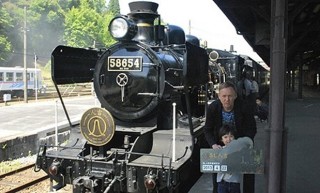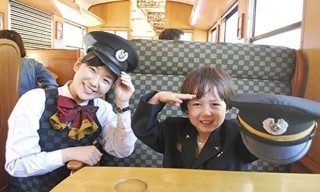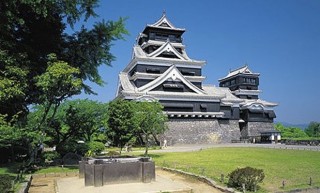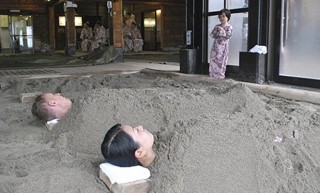Loading
Search
▼ Japan: Kyushu by Train
- Category:Tourism

THE GUARDIAN
by Richard Barnes
In this year's Reader Awards, you voted the Land of the Rising Sun your favourite long-haul destination (again). Richard Barnes and family explore Kyushu island by rail.
"It's coming daddy, it's coming!" I was ready with my camera when the Sonic pulled into platform two at Yukuhashi station, right on time. Roka, my four-year-old son, was brimming with excitement. He liked to play with his toy trains back at home in London and had a model of the distinctive metallic-blue 883 series express, which had been sent to him by "obachan", his Japanese grandma.
My wife Yuko, Roka and I were about to embark on a five-day rail journey around Kyushu, the third largest of the country's main islands, using the "limited express" trains – of which the Sonic was one – and the hi-tech, high-speed shinkansen (bullet train) system. The first thing that attracted us to the idea of travelling around Kyushu by rail was the ridiculously cheap passes only available to overseas visitors – a five-day pass for the island costs just over £100, nine times cheaper than a single day on the new, much-heralded Kyushu Seven Stars luxury train, which costs from £980 per person for a two-day/one-night train "cruise".

The second thing was its colourful array of limited express trains, which often display a faded European-style grandeur, with wooden panelling and stylish buffet cars. But despite this ageing fleet, Japan's rail network is one of the fastest, most efficient and widely used in the world.
On board the Sonic, with its yellowing wooden floorboards and natty red-leather headrests, we zipped along. I imagined Godzilla striding over the tree-covered mountains, sparks flying as he ripped through the electricity pylons. As well as trains, we were looking forward to seeing a volcano, and the forest that inspired one of my four-year-old son's favourite films – Hayao Miyazaki's animated classic, Princess Mononoke.
Our first stop was Beppu, a hot spring resort/spa town in Kyushu's north-west, home of the Mount Takasaki monkey park.
A cable-car leads up to a spectacular viewing spot where we admired Beppu Bay before being deluged by hundreds of red-faced macaques coming down the mountain. Roka was scared. We found refuge back at Beppu station before heading on to Mount Aso, via the pretty onsen (hot-spring) town of Yufuin.
The taxi driver from Aso station informed us that the mountain consists of five peaks naturally laid out in the shape of a Buddha – only visible from a special viewing point – and that the area is popular for hiking. What we hadn't realised was access to the crater's edge sometimes isn't possible because of the emission of dangerous volcanic gases.
Deflated, we returned to the windswept grassy plain below, which featured a couple of small lakes and a line-up of rather downbeat looking horses giving people rides.. But after taking photos of ourselves with the smoking crater in the distant background, we saw that the road had been reopened and hurried back to our waiting driver. This time we got as far as the summit before a siren wailed and noxious gases hit my lungs. As we were driving out, we looked back at an alien landscape of blackened soil and rock, mini-concrete shelters dotted about and people scurrying away, mouths covered with hands and scarves.
Back at the station, the Aso Boy train (asobouyo means "let's play") seemed to have been designed with children in mind, with its Kuro-the-dog logo and special carriage featuring white-leather, child-only seats, a wooden ball pool and library. As we headed back towards Kumamoto, I watched as Roka noisily played with the other children and chatted enthusiastically in Japanese to the attendant, whose sole responsibility seemed to be to entertain the infants. "Oh," Roka exclaimed as I told him we were about to get off the train. "I don't want to go."
The following day, we visited Hitoyoshi, principally because we wanted to take the steam train for the return journey, although the town itself turned out to be an unexpectedly pleasant place to spend a few hours.
From the station we walked a circular route that took in the Aoi Aso shrine (a Japanese national treasure), a samurai house and Eikoku temple, notable for its ancient image of a vengeful female ghost – a staple of Japanese mythology.

On board SL Hitoyoshi, a steam locomotive built by Hitachi in 1922 and restored to service in 2009, we got to have our photographs taken in drivers' caps and jackets, and stopped off at several old wooden stations – one of which had an impromptu bargain-price ekiben sale. Ekiben are popular bento-style lunchboxes sold at railway stations throughout the country and each area has its own speciality. The quality and variety is generally excellent and it's a good-value way to sample Japanese food on the move.
That night we stayed at the western-style Nikko hotel in the centre of Kumamoto with a room overlooking the castle we were to visit the next morning and ate at the nearby Tokuichi restaurant. We were shown to our private tatami room and, with the downbeat horses at Aso in mind, I guiltily ordered basashi (horsemeat sashimi), for which Kumamoto is famed. The raw, dark-red pieces of meat streaked with fat were quite similar to beef, slightly sweet and well-complimented by a soy sauce and ginger dip. More challenging was another Kumamoto delicacy, karashi renkon: lotus root liberally stuffed with mustard.
Kumamoto's early 15th-century castle is one of the three most important in Japan. Much of it was destroyed by fire in 1877 during the Satsuma rebellion, a samurai revolt against the imperial government, although some original structures and the formidable stone walls survived. Roka enjoyed looking at the swords and guns, and chatted enthusiastically with the actors dressed as samurai who roamed the castle grounds.
That afternoon, the shinkansen sped us onwards to Kagoshima, and we checked in at the recently built Remm hotel – complete with in-room massage chair – and ate at a shabu shabu restaurant, sampling some of the melt-in-the-mouth-tender local black pork from pigs fed on a diet of sweet potatoes. The city itself is overlooked by an active volcano that periodically covers the city with ash.
Nearby, in Ibusuki, the volcanic activity is underground, making the resort famous for its natural hot-sand baths. To try it, we put on our yukatas – lightweight cotton kimonos – and lay down while an attendant raked hot sand over us. Imagine having a sauna but covered in sand, the weight of which makes it feel as though all the bad stuff is being slowly pushed out of your body. After about 15 minutes of being slowly baked – Roka only managed a minute or two before he got too hot – we broke out of the sandy cocoons, brushed ourselves down and headed for the onsen. These are usually gender-segregated and can be intimidating if you're not used to them, but the etiquette is straightforward enough: undress completely and take a small hand towel, which is usually provided; wash sitting on one of the stools at the specially designated area; using the towel for modesty if you wish, slide gently into the bath; after you've soaked, return to the dressing area to dry off and get dressed. Oh, and don't wring out your towel – too late, I discovered it's considered rude, although the Japanese tend to be understanding with foreign visitors.

The next morning we were up early for a breakfast of fish, egg, rice, pickles, miso soup and green tea before catching the ferry to Yakushima, an island designated as a Unesco world heritage site in 1993.
We took a bus up a steep, winding mountain road and arrived at Shiratani Unsuikyo, the ancient cedar forest that provided the inspiration for Princess Mononoke. We spent the day trekking through moss-covered woodland along Edo-period paths of rock and twisted root, wild deer occasionally emerging from the greenery and even a monkey or two – those red-faced macaques again – climbing around in the trees above. It was quite magical, despite having to bribe Roka with sweets to walk when he got tired. That night, we had arranged to stay at Shikinoyado Onoaida, a friendly, family-run Japanese-style minshuku (B&B) on the island, and were greeted with a sashimi dinner that used local organic produce. Yuko especially enjoyed the unusual miso soup that used a sea shell called "turtles feet" for flavouring.
On the day before our train pass expired, we had to get back to Fukuoka, although we managed to find time to stop off and take in a waterfall and spend a few hours exploring rock pools for crabs and tropical fish on a deserted beach as we headed back to the island's ferry terminal by bus.
We arrived back in Kagoshima mid-evening with the shadow of Sakurajima volcano just visible in the gloaming and we were soon back in the comforting embrace of the Tsubame shinkansen. While an exhausted
Yuko and Roka slept, I settled back into my seat with an ice-cold Asahi beer as, at 200mph, we were whisked quietly through the Kyushu countryside.
- November 3, 2015
- Comment (0)
- Trackback(0)

